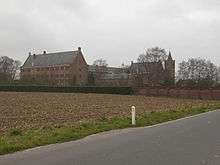Affligem Abbey
Affligem Abbey is a Benedictine monastery in the municipality of Affligem, Flemish Brabant, Belgium, 19 kilometres (12 miles) to the north-west of Brussels. Dedicated in 1086, it was the most important monastery in the Duchy of Brabant and therefore often called Primaria Brabantiae.

First foundation
On the 28th of June, 1062, an hermitical fraternity was founded in Affligem by six knights who repented of their violent way of life. Hermann II, Count Palatine of Lotharingia (1061–1085) and his guardian, Anno II, archbishop of Cologne (d. 1075) donated the foundation grounds. On this land, the first abbey church, dedicated to St Peter, was erected in 1083. The Benedictine Rule was adopted in 1085, followed by the formal dedication of the abbey in 1086.
The counts of Brabant, also counts of Leuven, became their protectors (Vögte) in 1085/1086. A number of their family members are buried in the abbey church, including Queen Adeliza of England (d. 1151), as well as her father Duke Godfrey I of Leuven (d. 1139). Queen Adeliza was buried in the abbey church in 1151, near the clockwork.
During the 12th century, the abbey became known for the strict adoption of the Cluniac observance.
John Cotton, whose "De musica" (c. 1100-1121) is one of the earliest musical theses, covers the ecclesiastical use of monody in the organum and the roots of polyphony.
Saint Bernard of Clairvaux visited Affligem in 1146, where it is said his greeting to the Blessed Virgin was miraculously answered. In memory of this event, he donated his staff and chalice to the abbey (still preserved in the abbey).
Jan of Afflighem, Jan van Ruusbroec's Good Cook in the Groenendaal monastery near Brussels, was important for the survival of theology in the wake of the Black Death. His theology strongly influenced Gerard Groot, who taught Thomas à Kempis.[1]
Several monasteries were founded by the monks of Affligem or assigned to the abbot of Affligem by their founder (i.e. Maria Laach Abbey in Germany).
In 1523, Affligem joined the Bursfelde Congregation, a union of Benedictine monasteries formed in the 15th century for the stricter observance of the Benedictine rule. In 1569, the Archbishop of Mechelen became secular abbot and the spiritual duty was exercised by a provost (praepositus), a measure that lasted until the dissolution of the abbey in 1796.
Archbishop Jacob Boonen introduced the Monte Cassino observance. At his insistence, the Prior of Affligem, Benedict van Haeften, founded in 1627 a new congregation, B. M. V. in Templo Praesentat, which included Affligem and several other Belgian monasteries. It was dissolved in 1654.
In 1796, during the French occupation, the monks were chased away from the abbey, part of the buildings destroyed and the lands confiscated. The last provost, Beda Regaus, preserved the miraculous image of Our Lady, as well as the staff and chalice of Saint Bernard. These came into the possession of a Benedictine monk, Veremund Daens, who in 1838 established a new foundation at Dendermonde.
Second foundation
In 1869/70, the abbey of Affligem was re-established. It is now a member of the Flemish Province of the Subiaco Congregation within the Benedictine Confederation.
Abbots
The first abbot of the abbey was Fulgentius (1088–1122). Among his prominent successors may be mentioned:
- Franco (1122–1135), author of De Gratia Dei in twelve books (Patrologia Latina, vol. 166, 717-080);
- Albert, whose devotion to the Virgin Mary won him the title Abbas Marianus;
- Benedict van Haeften, author of several works of art.
Burials
- Godfrey I of Leuven
- Adeliza of Leuven, Queen of England
- Marie of France, Duchess of Brabant
References
- Bollandist Life of Ruusbroec, Brussels 1885
External links
- (in Dutch) Affligem Abbey
- Affligem Abbey image:
- Affligem Stamp image:
![]()